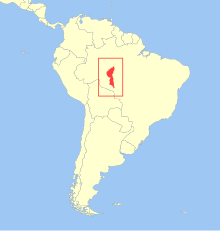Prince Bernhard Spring Monkey
| Prince Bernhard Spring Monkey | ||||||||||||
|---|---|---|---|---|---|---|---|---|---|---|---|---|
| Systematics | ||||||||||||
|
||||||||||||
| Scientific name | ||||||||||||
| Plecturocebus bernhardi | ||||||||||||
| ( M. van Roosmalen , T. van Roosmalen & Mittermeier , 2002) |
The Prince Bernhard Spring monkey ( Plecturocebus bernhardi , Syn .: Callicebus bernhardi ) is a species of primate from the subfamily of the jumping monkeys within the family of the sakia monkeys (Pitheciidae). The species was described in 2002 , the name honors the Dutch Prince Bernhard , the founding president of the WWF .
features
Like all spring monkeys, Prince Bernhard's jumper monkeys are relatively small primates with thick fur. They reach a length of 36 to 37 centimeters, the tail is significantly longer at 55 centimeters. The weight of two weighed specimens was 0.7 and 1.2 kilograms. The fur is predominantly gray in color on the upper side and the flanks, the back can turn brownish, the belly and the inside of the limbs contrast strongly with an orange-red color. The long, orange-colored, beard-like hair on the cheeks is striking. The tail is very bushy and black in color; like all jumper monkeys, it cannot be used as a prehensile tail.
distribution and habitat
Prince Bernhard's jumping monkeys only occur in the Amazon basin in Brazil . Their range is limited to the west by the Rio Madeira and to the east by the Rio Aripuanã . Their habitat are forests, they occur in different forest types.
Way of life
The way of life of the Prince Bernhard monkeys is hardly known, it should correspond to that of the other jumper monkeys. Jumper monkeys are diurnal tree dwellers that either move on all fours or jump through the branches. They live in family groups made up of a longstanding monogamous couple and their offspring. They are territorial, with duet songs the couples point out other animals to their own territory.
Their diet consists primarily of fruits. To a lesser extent, they also consume leaves and possibly insects. As with all jumping monkeys, the father is likely to participate intensively in the rearing of the young, he is the main carrier and only gives the child to the mother to suckle.
Danger
Prince Bernhard monkeys live in a sparsely populated area that is relatively untouched by humans. According to the IUCN, they are therefore not endangered species.
literature
- Thomas Geissmann : Comparative Primatology. Springer-Verlag, Berlin et al. 2003, ISBN 3-540-43645-6 .
- Marc GM van Roosmalen, Tomas van Roosmalen and Russell A. Mittermeier: A Taxonomic Review of the Titi Monkeys, Genus "Callicebus" Thomas 1903, with the description of two new species: "Callicebus bernhardi" and "Callicebus stephennashi", from Brazilian Amazonia . In: Neotropical Primates 10, 2002, ISSN 1413-4703 , pp. 1-52, PDF .
- Don E. Wilson, DeeAnn M. Reeder (Eds.): Mammal Species of the World. A taxonomic and geographic Reference. Johns Hopkins University Press, Baltimore MD 2005, ISBN 0-8018-8221-4 .
